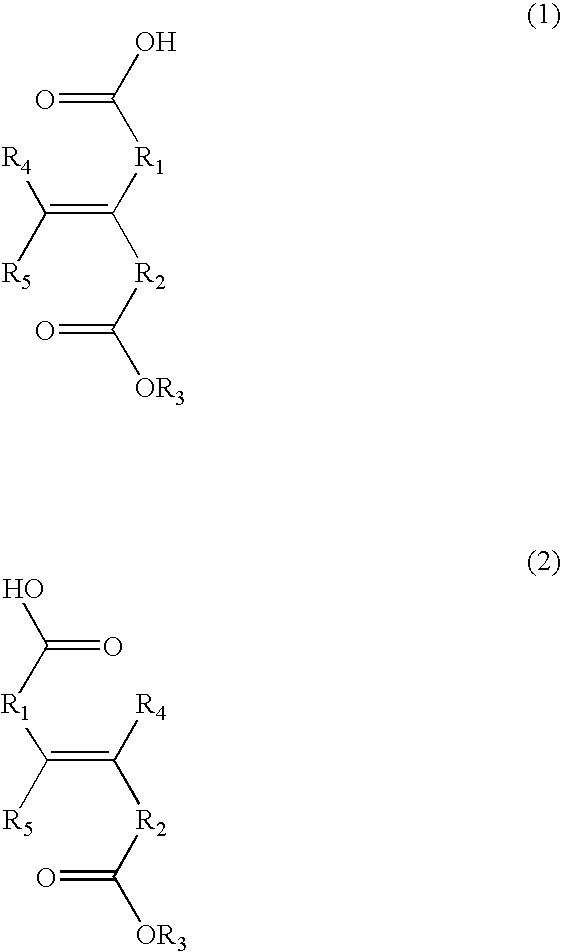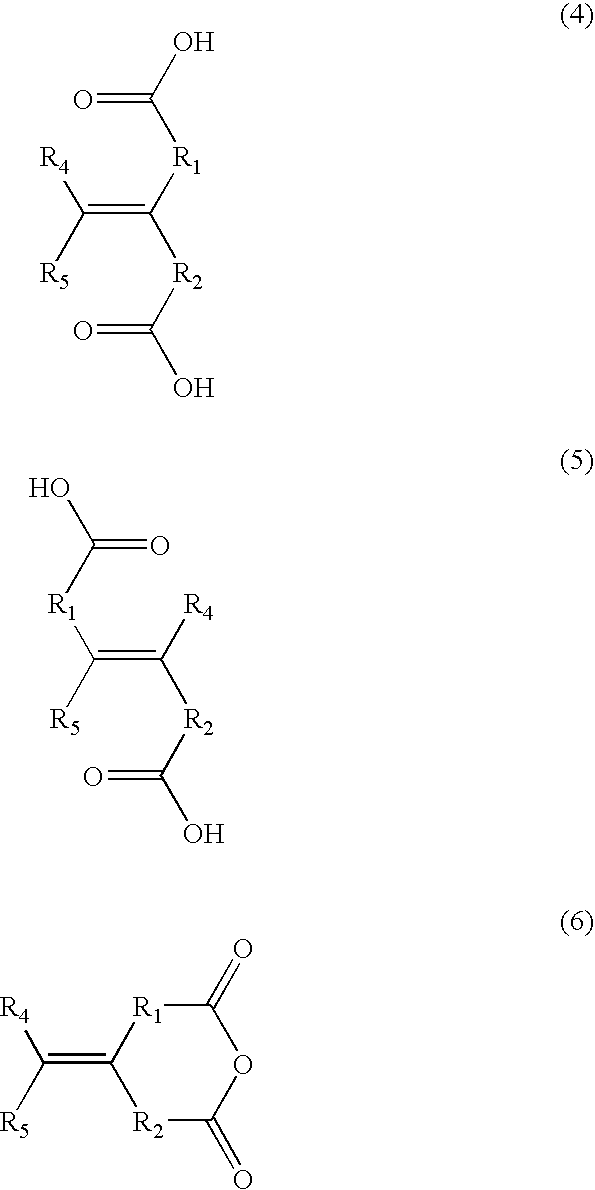Negative resist composition and process for formation of resist patterns
- Summary
- Abstract
- Description
- Claims
- Application Information
AI Technical Summary
Benefits of technology
Problems solved by technology
Method used
Image
Examples
example 1
[0048] As a specific example of the dicarboxylate monoester compound according to the present invention, monoisobornyl itaconate was synthesized as follows.
[0049] (i) Reaction of Itaconic Acid Anhydrate with Borneol
[0050] 200.0 g of itaconic acid anhydrate (1.78 mol), 183.6 g of borneol (1.19 mol), 100.0 g of propylene glycol monomethyl ether acetate and 0.02 g of p-methoxyphenol were placed in a reaction vessel and heated at 90° C. with stirring. It was avoided to polymerize monomers in an asphyxiant condition by performing air-bubbling during the reaction. The reaction was followed up by measuring an acid value using a potentiometric titration apparatus, and the reaction was completed at the time when the acid value was scarcely changed.
[0051] (ii) Liquid Separation and Purification
[0052] An organic layer was separated from an aqueous layer by adding a separation solvent to the reaction solution obtained above at a ratio of the reaction solution / n-hexane / water=1 / 2 / 1 (weight ra...
example 2
[0059] Subsequently, an example in which a copolymer having a dicarboxylate monoester structural unit was synthesized using the monoisobornyl itaconate ester yielded in the above Example 1 will be shown.
[0060] 0.4 g of α-(hydroxymethyl)acrylic acid methyl (90.3 mmol) represented by the following general formula (10), 11.7 g of α-(hydroxymethyl)acrylic acid ethyl (90.3 mmol) represented by the following general formula (11) and 1.4 g of azobisisobutylolactonitrile which is a polymerization initiator were dissolved in 400 mL of THF (tetrahydrofuran). Into the thus obtained solution, 12.0 g of monoisobornyl itaconate (45.1 mmol) represented by the following general formula (9) was dropped in small amounts.
[0061] Nitrogen bubbling was performed to this solution for about 10 minutes, the solution was stirred for 4 hours during heating using a water bath at 70° C., and subsequently cooled to room temperature. The solution was exsiccated by drying under reduced pressure at 50° C. for 30...
example 3
[0064] A copolymer represented by the following structural formula (13) was prepared as follows:
wherein, 1 / m was 30 / 70.
[0065] 6.0 g of monoisobornyl itaconate (22.6 mmol) yielded in the above Example 1, 6.1 g of α-(hydroxymethyl)acrylic acid methyl (52.6 mmol) and 0.5 g of azobisisobutylolactonitrile which is the polymerization initiator were dissolved into 150 mL of THF (tetrahydrofuran).
[0066] Nitrogen bubbling was performed to this solution for about 10 minutes, the solution was stirred for 4 hours with heating using the water bath at 70° C., and subsequently cooled to the room temperature. This solution was exsiccated by drying under reduced pressure at 50° C. for 30 minutes. Further, this was dissolved in THF, filtrated and dried under reduced pressure using a mixed solvent of 820 mL of heptane and 180 mL of isopropyl alcohol, and purified to collect crystals.
[0067] The weight-average molecular weight in terms of polystyrene was about 3,000 and the degree of dispersion wa...
PUM
| Property | Measurement | Unit |
|---|---|---|
| Electrical resistance | aaaaa | aaaaa |
Abstract
Description
Claims
Application Information
 Login to View More
Login to View More - R&D
- Intellectual Property
- Life Sciences
- Materials
- Tech Scout
- Unparalleled Data Quality
- Higher Quality Content
- 60% Fewer Hallucinations
Browse by: Latest US Patents, China's latest patents, Technical Efficacy Thesaurus, Application Domain, Technology Topic, Popular Technical Reports.
© 2025 PatSnap. All rights reserved.Legal|Privacy policy|Modern Slavery Act Transparency Statement|Sitemap|About US| Contact US: help@patsnap.com



